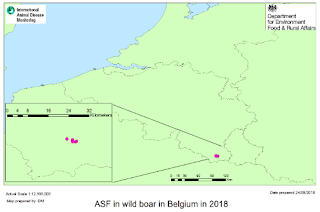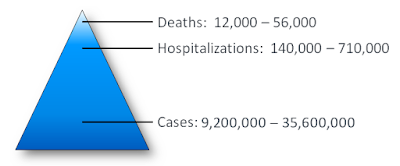#13,550
After months of very little avian flu activity reported from China - likely due to their aggressive poultry vaccination program launched last summer - over the past few weeks we've seen a slight uptick in H5N6 activity.
In August, we saw Guangxi Province Report Their 3rd Human H5N6 Infection - and only the 2nd case of 2018 - and just yesterday we saw An HPAI H5N6 Outbreak In Guizhou Province Poultry.In the past few hours Hong Kong's CHP has posted a notification of a new H5N6 infection in Guangzhou in Guangdong Province. This is the 8th case reported from Guangdong Province since the virus emerged in 2014, and the first there in 30 months.
The patient is a 22 year old man reported to be in serious condition. He apparently had recent contact with live poultry.Although we've only seen full notifications of 20 cases (hence the numbering in the graphic above), 1 additional case is known to have been reported to the WHO - making this the 21st human case on record.
Gaps in surveillance and testing - which we've discussed before - may also contribute to these relatively low numbers.While two cases - 5 weeks and 500 km apart - isn't what you would call a trend, traditionally August and September are pretty quiet months for avian flu in China. Nearly half (n=9) of all human H5N6 infections have been reported in either November or December.
These last two cases, in fact, are the only H5N6 infections to be reported in either August or September. Its close proximity to Hong Kong (75 miles) is also worth noting.The HK CHP announcement follows:
HP notified of human case of avian influenza A(H5N6) in Guangdong
The Centre for Health Protection (CHP) of the Department of Health (DH) today (September 30) received notification of an additional human case of avian influenza A(H5N6) in Guangdong from the National Health Commission, and again urged the public to maintain strict personal, food and environmental hygiene both locally and during travel.
The case involved a 22-year-old man from Guangzhou in Guangdong. He developed symptoms on September 25 and was hospitalised on the next day. He is now in a serious condition. The patient had contact with live poultry before the onset of symptoms.
From 2014 to date, 21 human cases of avian influenza A(H5N6) have been reported by the Mainland health authorities.
"All novel influenza A infections, including H5N6, are notifiable infectious diseases in Hong Kong," the spokesman said.
Travellers to the Mainland or other affected areas must avoid visiting wet markets, live poultry markets or farms. They should be alert to the presence of backyard poultry when visiting relatives and friends. They should also avoid purchasing live or freshly slaughtered poultry, and avoid touching poultry/birds or their droppings. They should strictly observe personal and hand hygiene when visiting any place with live poultry.
Travellers returning from affected areas should consult a doctor promptly if symptoms develop, and inform the doctor of their travel history for prompt diagnosis and treatment of potential diseases. It is essential to tell the doctor if they have seen any live poultry during travel, which may imply possible exposure to contaminated environments. This will enable the doctor to assess the possibility of avian influenza and arrange necessary investigations and appropriate treatment in a timely manner.
While local surveillance, prevention and control measures are in place, the CHP will remain vigilant and work closely with the World Health Organization and relevant health authorities to monitor the latest developments.
The CHP's Port Health Office conducts health surveillance measures at all boundary control points. Thermal imaging systems are in place for body temperature checks on inbound travellers. Suspected cases will be immediately referred to public hospitals for follow-up.
The display of posters and broadcasting of health messages in departure and arrival halls as health education for travellers is under way. The travel industry and other stakeholders are regularly updated on the latest information.
The public should maintain strict personal, hand, food and environmental hygiene and take heed of the advice below if handling poultry:
The public may visit the CHP's pages for more information: the avian influenza page, the weekly Avian Influenza Report, global statistics and affected areas of avian influenza, the Facebook Page and the YouTube Channel.
- Avoid touching poultry, birds, animals or their droppings;
- When buying live chickens, do not touch them and their droppings. Do not blow at their bottoms. Wash eggs with detergent if soiled with faecal matter and cook and consume the eggs immediately. Always wash hands thoroughly with soap and water after handling chickens and eggs;
- Eggs should be cooked well until the white and yolk become firm. Do not eat raw eggs or dip cooked food into any sauce with raw eggs. Poultry should be cooked thoroughly. If there is pinkish juice running from the cooked poultry or the middle part of its bone is still red, the poultry should be cooked again until fully done;
- Wash hands frequently, especially before touching the mouth, nose or eyes, before handling food or eating, and after going to the toilet, touching public installations or equipment such as escalator handrails, elevator control panels or door knobs, or when hands are dirtied by respiratory secretions after coughing or sneezing; and
- Wear a mask if fever or respiratory symptoms develop, when going to a hospital or clinic, or while taking care of patients with fever or respiratory symptoms.
Ends/Sunday, September 30, 2018
Issued at HKT 22:51



























